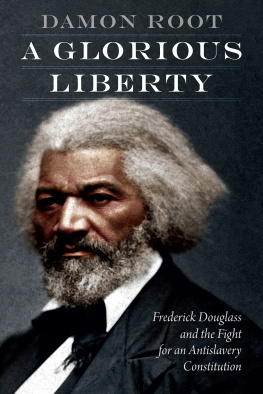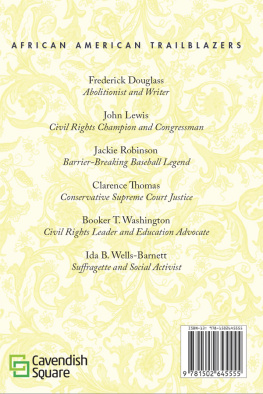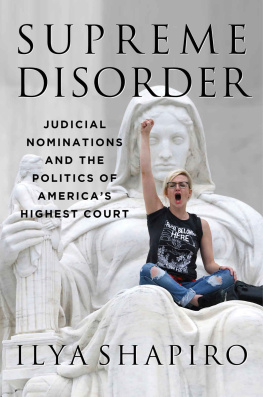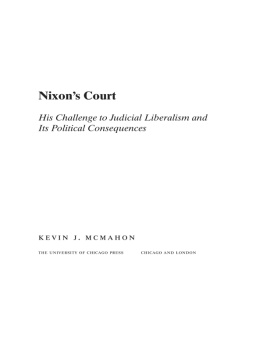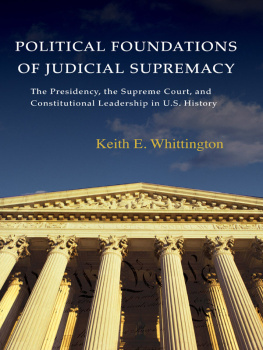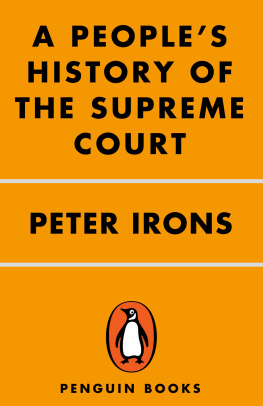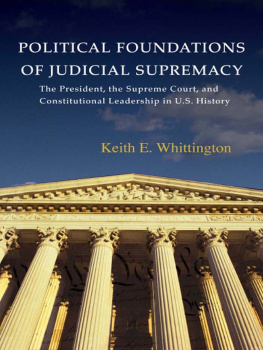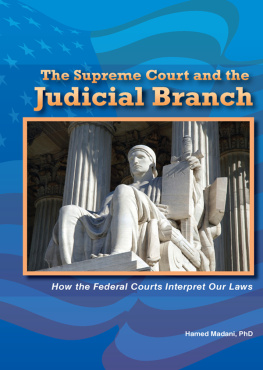O v erruled
The Long War for Control of the U.S. Supreme Court
Damon Root

The author and publisher have provided this e-book to you for your personal use only. You may not make this e-book publicly available in any way. Copyright infringement is against the law. If you believe the copy of this e-book you are reading infringes on the authors copyright, please notify the publisher at: us.macmillanusa.com/piracy .
Dedicated to my mother and to the memory of my father.
Contents
Introduction
The Long War
Can the federal government make you eat your fruits and vegetables? Supreme Court nominee Elena Kagan seemed to think so. It was June 29, 2010, the second day of Kagans confirmation hearings before the Senate Judiciary Committee, and Republican Tom Coburn of Oklahoma wanted to know whether she thought Congress possessed the constitutional power to force every American to eat three vegetables and three fruits every day. In response, the future Supreme Court justice laughed and said that while it sounds like a dumb law, that did not make it an unconstitutional one. The [principal] protector against bad laws is the political branches themselves, Kagan said. In other words, if you dont like what your lawmakers have done, take your complaint to the ballot box, not to the courthouse.
It was the classic case for judicial restraint, the idea that judges should defer to the will of the majority and refrain from striking down most democratically enacted laws, even the really dumb ones. As a model for this approach, Kagan cited the example of Supreme Court Justice Oliver Wendell Holmes Jr. He was this judge who lived... in the early twentieth century, Kagan explained. He hated a lot of the
Appointed in 1902 by President Theodore Roosevelt, Justice Holmes was one of the Supreme Courts earliest and most influential advocates of judicial restraint or, as he once described it, the right of a majority to embody their opinions in law.
That view may sound harsh, but it didnt prevent Holmes from being adopted as a hero by the American left, particularly among the assorted reformers, activists, and politicians laboring under the banner of Progressivism, the turn-of-the-century movement that sought to create a vast new regulatory state to combat the perceived evils of industrial capitalism. Holmes was a sage with the bearing of a cavalier, As the Progressives saw it, if more judges would only follow the example set by Holmes, the reform movement would be free to make the government as big and powerful as it needed to be.
So Elena Kagan wasnt just showing off her knowledge of arcane legal history by invoking Holmes before the Senate Judiciary Committee that day; she had placed herself squarely within a long and venerable legal tradition that seeks to give the government wide control over regulatory affairs while simultaneously preventing most interference from the courts. And as it turned out, Kagan would not be the only Holmesian on the bench.
Almost exactly two years later, on June 28, 2012, Holmes returned to the political stage once more, this time as one of the deciding factors in the biggest legal battle of the modern era, the clash over the constitutionality of President Barack Obamas sweeping health care overhaul, the Patient Protection and Affordable Care Act.
After a years worth of skirmishing in the lower courts, the Supreme Court was finally set to announce its eagerly anticipated decision on the health care law that morning. Although the case against health care reform was initially dismissed by the president and his allies as a partisan stunt, the legal challenge had slowly gathered steam, winning first at the federal district court level and then, more significantly, at the U.S. Court of Appeals for the Eleventh Circuit, where a federal judge appointed by President Bill Clinton joined the majority in voting against the Obama administration. We have not found any generally applicable, judicially enforceable limiting principle that would permit us to uphold the [health care law] without obliterating the boundaries inherent in the system of enumerated congressional powers, the Eleventh Circuits ruling declared. To top it all off, not only had the Supreme Court recognized the seriousness of the challenge by setting aside three days to hear oral arguments in the casea modern recordthose three days had not appeared to go very well for the federal government.
Indeed, not only had conservative justices like Antonin Scalia and Samuel Alito seemed hostile to the Obama administrations case, which rested principally on the theory that Congress could require every American to buy health insurance as part of its power to regulate
The stage appeared to be set for a landmark conservative victory. But then something else happened. In a decision that shocked many observers and infuriated most of the right, Chief Justice John Roberts, a veteran of Ronald Reagans Justice Department and an appointee of George W. Bush, broke with his usual allies and sided instead with the Courts liberals. Thanks to Roberts, the health care law was upheld by the narrowest of margins: five votes to four.
Why did Roberts do it? He said it was an act of judicial restraint. Starting with the premise that legal statutes are owed a full measure of deference
In other words, Roberts tipped the scale in favor of the government. It is not our job, declared the chief justice of the United States, taking yet another page from Holmess playbook, to protect the people from the consequences of their political choices. Let them go to hell.
But Roberts had not actually betrayed legal conservatism; he had simply followed one of two possible conservative paths in the case. Judicial restraint, as Roberts well understood, was not only a touchstone of the Progressive left; it was also a philosophy adopted by many members of the modern right. Conservative icon Robert Bork, for example, the former Yale law professor and federal judge whose failed 1987 Supreme Court nomination had galvanized Republicans and set the stage for future judicial confirmation battles, was an outspoken proponent of granting Holmes-style deference to the elected branches of government. As Bork argued in his bestselling book The Tempting of America, the first principle of the U.S. system was not individual rights; it was majority rule, which meant that when it came to the vast preponderance of political disputes, the courts should simply butt out. In wide areas of life, Bork wrote, majorities are entitled to rule, if they wish, simply because they are majorities.
Bork and other conservatives employed this approach most famously when it came to the issue of abortion. In their view, the Courts 1973 ruling in Roe v. Wade, which recognized a womans constitutional right to an abortion, the Supreme Court had effectively overturned the abortion laws of all fifty states, substituting its judgment for the will of the people in every one of those places. Under the majoritarian deference espoused by Bork (and Holmes before him), each state would be free to set its own abortion policyincluding a total prohibition on the procedurewithout interference from the federal courts. Judicial restraint would therefore accomplish one of the central goals of modern conservatism: the death of Roe v. Wade.
That was the path taken by Roberts in the health care case. The only problem was that very few conservatives wanted to join him for the ride. Instead of seeking judicial deference, they wanted the justices to nullify President Obamas signature legislative achievement and overrule the elected branches of governmentsomething the Supreme Court had not done since the great legal battles over Franklin Roosevelts New Deal in the 1930s.
Next page

